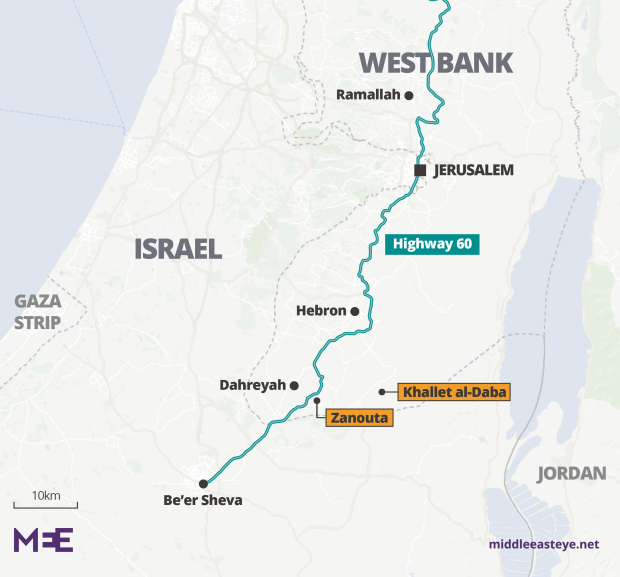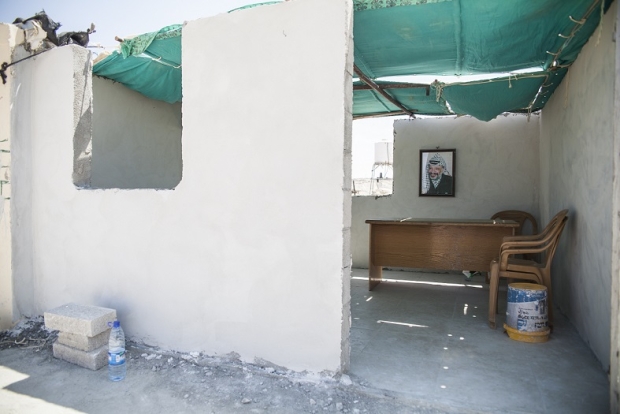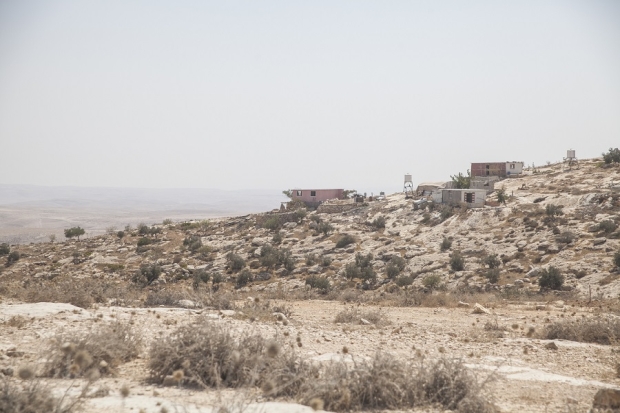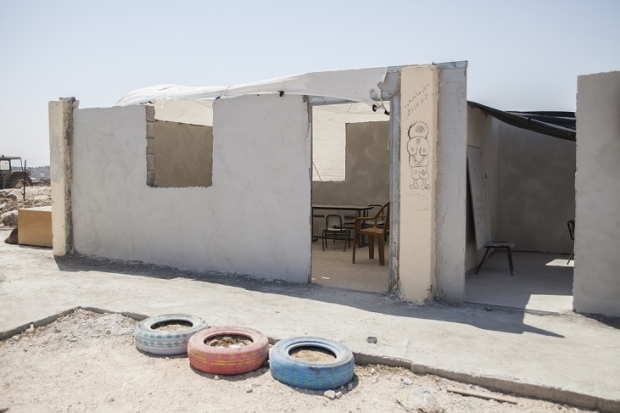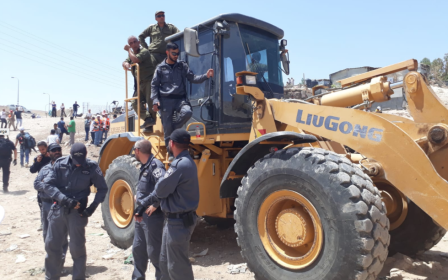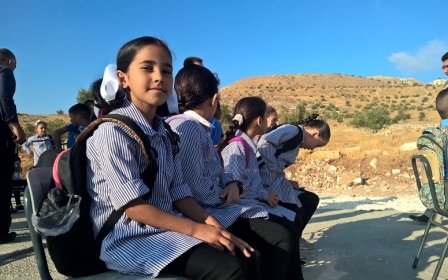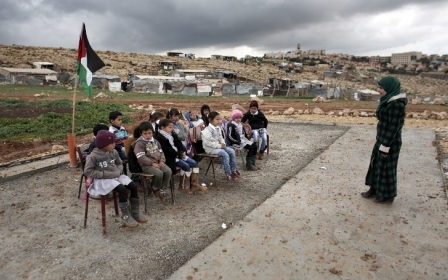Destruction in the desert looms for Palestinian schools in the West Bank

Zanouta, West Bank - In the intense desert heat, five-year-old Aalia Issa sits in a village school made of cement blocks and a tarpaulin roof.
She’s extremely shy, but wants to express how much she enjoys going there each day. “They teach us and give us trophies and rewards for being intelligent,” Issa said.
To me, this is a city and it should have all the services A to Z, including schools ... It’s a right our children have to education
- Jaber Ali Dababsha, Khallet al-Daba resident
Though only in kindergarten, Issa has already seen how easily her education could be taken away from her.
Twenty days after the people of Zanouta, south of Hebron, built their first school this March out of cement blocks and tin sheets, Israeli forces dismantled it in the night with bulldozers, saying that it had been constructed without the right permits.
Undeterred, village residents bought new materials and rebuilt the school over the summer. But when Aalia and other students arrived for their first day of school last week, they were greeted by a notice from Israeli authorities: they could either dismantle the school or it would be demolished in seven days.
The school is one of 44 across the West Bank that are at risk of complete or partial demolition, according to the UN Office for the Coordination of Humanitarian Aid (OCHA).
Most of those affected are in Area C, which constitutes about 61 percent of the West Bank and has been completely under Israeli control since the 1993 Oslo accords.
Around 300,000 Palestinians live here, yet between Israeli demolitions of schools and the routine rejection of Palestinian requests to build replacements, one third of the population don’t have primary schools.
The Coordination of Government Activities in the Territories (COGAT), the agency responsible for implementing Israeli policy in the West Bank, told MEE that few Palestinian residents file applications to build.
“It should be emphasised that the number of requests submitted by Palestinian residents is generally very low,” COGAT said in a written response.
It’s part of a policy by the Israeli government to make certain areas unlivable for Palestinians... Children unfortunately pay the price
- Omar Shakir, HRW Israel and Palestine director
“The Civil Administration examines each allocation request submitted to it on an individual basis, in accordance with the criteria determined in its procedures and the instructions of the political echelon.
“In addition, the Civil Administration is examining plans for the purpose of building educational institutions according to planning laws and procedures.”
Human rights advocates, meanwhile, say the permit process is a farce disguising entrenched discrimination and violations of international law.
Omar Shakir, Israel and Palestine director at Human Rights Watch, said the Israeli military routinely rejects Palestinian building requests, leaving just 1 percent of the area for Palestinian development.
“It’s part of a policy by the Israeli government to make certain areas unlivable for Palestinians and essentially create conditions that lead to forcible transfer,” he said.
“Children unfortunately pay the price."
Hiking to learn
Zanouta is situated on a hill overlooking Highway 60, a settler road which gives Israeli citizens access from the West Bank all the way to Beersheba, the main Israeli city in the Negev Desert.
It appears like a Bedouin village - mainly built from tarps and temporary structures – but is a Palestinian farming community with its residents mainly working the land and raising goats.
Khalil al-Tel, a 36-year-old Zanouta resident, told MEE that they built the school this spring so their children would have access to an education.
Before the school, which serves 40 children, including those from another Palestinian community close by, anyone who wanted to learn would have had a long hike.
“The closest school to us is Dahreyah city and on foot it’s about 7km,” Al-Tel said as he pointed to another village in the dusty mountain haze. “As an adult, can you walk every day one hour and a half in the morning and in the afternoon?”“In addition, this is an apartheid road,” he said, pointing at an Israeli-only roadway that the children would have to cross. “No one can guarantee their safety. Even if you want to cross this road here, you have to think 100 times before.”
The school opened on 26 March; on 10 April, Israeli forces demolished it. “They also stole all of the materials and tools that belong to the school,” said Al-Tel.
Classes continued on the floor of the remaining structure. Then this summer, the school was rebuilt with funds gathered from surrounding communities and the Colonization and Wall Resistance Commission, a part of the Palestinian Liberation Organisation (PLO).
Even if you want to cross this road here, you have to think 100 times before
- Khalil Al-Tel, Zanouta resident
Constructed with concrete blocks, the school is not considered a temporary structure, so by law, Israeli authorities must give notice before they demolish it.
“They [the Israeli forces] released drones in the area, so they [saw] that this school is built. The next day, they came and issued a demolition notice,” Al-Tel said.
‘This is a city’
Khallet al-Daba, at least an hour's drive west of Zanouta along a rocky road through mountains, has 13 children who attend school in the village, in grades one to four.
The soldiers came while the children were there. When they dismantled the school, they were yelling, shouting, crying
- Jaber Ali Dababsha, Khallet al-Daba resident
Their old school – which consisted of temporary structures and caravans - was demolished during the summer, so now the children study in a private house.
Jaber Ali Dababsha, 31, is the brother of the person who provides their house to the students.
“The kids were very frustrated. The soldiers came while the children were there. When they dismantled the school, they were yelling, shouting, crying,” Ali Dababsha told MEE.
“To me, this is a city and it should have all the services A to Z, including schools, [medical] clinics, infrastructure, water etc. It’s a right our children have to education, it’s important for their future, to establish their life.”
But residents fear that it’s only a matter of time until they receive a demolition notice for it.
Because Israeli authorities rarely grant Palestinians permits, communities like Khallet al-Daba often resort to building first, filing applications afterwards, and fighting it out in court.
If a demolition order is issued during this time, the residents refuse to give up.
“We will appeal it and we will go through all steps,” said Dababsha. “First court up to the Supreme [Court].”
COGAT would not comment specifically on what will happen to the Khallet al-Daba or Zanouta schools, but said generally that if construction “is carried out without a permit or planning, the Civil Administration operates according to the authority to implement the rule of law in relation to all illegal construction”.
Without the school, Dababsha said the children would need to walk to another nearby school, something he couldn’t fathom given the risks involved.
“If there’s no school here, we would not send them anywhere, we will keep them without education because all the way to the nearest school is full of settlers and soldiers. It’s not safe at all. Also it’s 3km of rough road,” he said.
Around 1,700 children regularly walk 5km or more one-way to get to school as a result of road closures or a lack of transportation in the West Bank, according to HRW.
According to Shakir from HRW, Palestinian children - particularly in Area C and areas surrounded by settlements – are frequently harassed and targeted either verbally or physically by Israeli settlers.
“[Travelling] these long distances or the harassment from settlers lead many parents to pull their children out of schools, which especially has an effect on young girls,” Shakir said.
Applying pressure
With all of the uncertainties for Palestinian students in the West Bank, particularly Area C, parents and community leaders are concerned their children will fall behind.
“Of course we worry. We want them to get an education. We are trying to make them get used to the situation here [in Zanouta], and with time we know they will catch up with other Palestinian school girls and boys that age,” Al-Tel said.
With time, we know they will catch up with other Palestinian school girls and boys that age
- Khalil Al-Tel, Zanouta resident
The Palestinian Authority minister of wducation was contacted multiple times to comment on the challenges faced by Palestinian school children in Area C, but was unavailable to be interviewed.
Arar with the Colonization and Wall Resistance Commission sees the expansion of Israel and illegal settlement construction as the reason behind the pressure being applied to Palestinian communities through the school demolitions.
“The plan here is obvious,” Arar said, standing in Zanouta. “About 6km behind us is the Green Line and over there is the Green Line again, over here is an [Israeli] industrial area and Shima settlement is there.
“They are trying to connect all of this land to the land occupied in 1948. They want these [Palestinian] communities to get out of here,” he said.
“[There is] also very strong international law not to interfere with education or destroying property. The justification Israel uses is not even based on security, they only say it’s a lack of permits,” Shakir said.
The international effort to cease these violations is a slow process, though Shakir sees there has been some movement on this issue in recent years.
“European countries that fund structures in Area C are going beyond routine condemnations and now ask to be reimbursed for property destroyed by Israel… it’s a step,” Shakir said.
The legal battle for Zanouta has begun: last week, the Resistance Commission applied with an Israeli court to license the school which would give it legal recognition under Israeli law. The chances of success are slim, Arar acknowledged.
“We know by experience that… [the success rate is] zero,” he said matter-of-factly.
Meanwhile, under the shadow of demolition and the tarpaulin-covered cement block school atop a hill, classes continue in Zanouta, and residents stand by, ready to rebuild again.
This article is available in French on Middle East Eye French edition.
New MEE newsletter: Jerusalem Dispatch
Sign up to get the latest insights and analysis on Israel-Palestine, alongside Turkey Unpacked and other MEE newsletters
Middle East Eye delivers independent and unrivalled coverage and analysis of the Middle East, North Africa and beyond. To learn more about republishing this content and the associated fees, please fill out this form. More about MEE can be found here.



